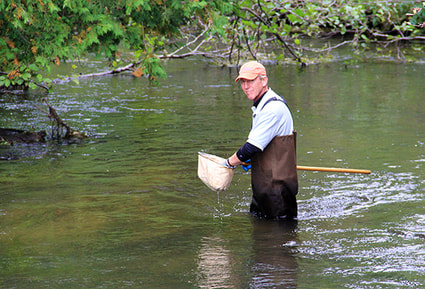Description:
The Pigeon River flows through sandy pine forests and dense lowland swamps as it meanders its way through northern Otsego and southern Cheboygan Counties, on its journey to Mullett Lake.
Quite a lot of folks recreate in this famous state-designated Natural River. Hunters and wildlife viewers scan the forests and meadows of its watershed for elusive deer, elk, black bear, and small game. Fishermen wade through the river looking for that big brookie, while paddlers quietly move by through challenging turns and obstacles. Hikers traverse mile upon mile of endless hilly trail, while campers sit around a fire telling their tales of adventure. Quite simply, the Pigeon River, and the Pigeon River Country it flows through, are an outdoorsman’s paradise.
Similarly, quite a lot of folks are dedicated to keeping the Pigeon River natural and protecting it. The Michigan Department of Natural Resources manages the 117 square mile Pigeon River Country for many different uses. Non-profit organizations, such as the Watershed Council, Little Traverse Conservancy, Trout Unlimited, Headwaters Land Conservancy, Huron Pines, and the Pigeon River Country Association work to protect the river and the surrounding lands. Countless individuals donate their time and money to conservation and preservation projects.
Other Threats to Water Quality
- Nonpoint source pollution
- Eroding riverbanks
Monitoring The Pigeon River is monitored every three years through the Watershed Council’s Comprehensive Water Quality Monitoring (CWQM) Program for dissolved oxygen, specific conductivity, pH, nitrate-nitrogen, total nitrogen, total phosphorus, chloride levels, and total suspended solids. Biological monitoring is also performed by volunteers in the Pigeon River each spring and fall as part of the Watershed Council’s Volunteer Stream Monitoring (VSM) Program. |
Additional Resources:
Michigan Trout Unlimited
Michigan Trout Unlimited is the grassroots organization of 19 local Michigan chapters of TU – over 7,500 individuals – devoted to the conservation, protection and restoration of Michigan’s coldwater fisheries and their watersheds.
Michigan Department of Natural Resources website
Information about Threatened, Endangered, and Special Concern species in this stream’s watershed is available on the Michigan Natural Features Inventory (MNFI) website.
Discharge data for this stream is available online through the Michigan Department of Environmental Quality’s Low Flow Discharge Data Base.
USGS Current Water Data for Michigan provides stream flow conditions.
A wide variety of maps, including Vegetation circa 1800, National Wetlands Inventory, Land Cover Change 1800’s to 1978, Wetland Change 1800’s to 1980, and many other resources for this area are available online in the Michigan Natural Features Inventory (MNFI) Data Resources page.
Learn about safely eating fish from this river in the Michigan Fish Consumption Advisory.
| Title | Link |
|---|
Insert Pigeon River Map


